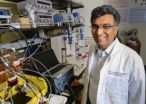(Press-News.org) Scientists at USC have developed a water-based organic battery that is long lasting, built from cheap, eco-friendly components.
The new battery – which uses no metals or toxic materials – is intended for use in power plants, where it can make the energy grid more resilient and efficient by creating a large-scale means to store energy for use as needed.
"The batteries last for about 5,000 recharge cycles, giving them an estimated 15-year lifespan," said Sri Narayan, professor of chemistry at the USC Dornsife College of Letters, Arts and Sciences and corresponding author of a paper describing the new batteries that was published online by the Journal of the Electrochemical Society on June 20. "Lithium ion batteries degrade after around 1,000 cycles, and cost 10 times more to manufacture."
Narayan collaborated with Surya Prakash, Prakash, professor of chemistry and director of the USC Loker Hydrocarbon Research Institute, as well as USC's Bo Yang, Lena Hoober-Burkhardt, and Fang Wang.
"Such organic flow batteries will be game-changers for grid electrical energy storage in terms of simplicity, cost, reliability and sustainability," said Prakash.
The batteries could pave the way for renewable energy sources to make up a greater share of the nation's energy generation. Solar panels can only generate power when the sun's shining, and wind turbines can only generate power when the wind blows. That inherent unreliability makes it difficult for power companies to rely on them to meet customer demand.
With batteries to store surplus energy and then dole it out as needed, that sporadic unreliability could cease to be such an issue.
"'Mega-scale' energy storage is a critical problem in the future of the renewable energy, requiring inexpensive and eco-friendly solutions," Narayan said.
The new battery is based on a redox flow design – similar in design to a fuel cell, with two tanks of electroactive materials dissolved in water. The solutions are pumped into a cell containing a membrane between the two fluids with electrodes on either side, releasing energy.
The design has the advantage of decoupling power from energy. The tanks of electroactive materials can be made as large as needed – increasing total amount of energy the system can store – or the central cell can be tweaked to release that energy faster or slower, altering the amount of power (energy released over time) that the system can generate.
The team's breakthrough centered around the electroactive materials. While previous battery designs have used metals or toxic chemicals, Narayan and Prakash wanted to find an organic compound that could be dissolved in water. Such a system would create a minimal impact on the environment, and would likely be cheap, they figured.
Through a combination of molecule design and trial-and-error, they found that certain naturally occurring quinones – oxidized organic compounds – fit the bill. Quinones are found in plants, fungi, bacteria, and some animals, and are involved in photosynthesis and cellular respiration.
"These are the types of molecules that nature uses for energy transfer," Narayan said.
Currently, the quinones needed for the batteries are manufactured from naturally occurring hydrocarbons. In the future, the potential exists to derive them from carbon dioxide, Narayan said.
The team has filed several patents in regards to design of the battery, and next plans to build a larger scale version.
INFORMATION:
This research was funded by the ARPA-E Open-FOA program (DE-AR0000337), the University of Southern California, and the Loker Hydrocarbon Research Institute.
USC scientists create new battery that's cheap, clean, rechargeable… and organic
2014-06-25
ELSE PRESS RELEASES FROM THIS DATE:
Using multiple pictures in an ad? Different perspectives can confuse consumers
2014-06-25
Have you ever wondered what it would be like to see the ocean from a private balcony at a luxury resort? Self-imagery is a powerful marketing tactic and many ads use pictures that help you see yourself using a product or service. According to a new study in the Journal of Consumer Research, showing photos from multiple perspectives can have a negative effect on how a person processes the information in an ad.
"The use of photos showing the advertised product or service from multiple perspectives is very common in ads. However, we show that these multiple perspective ads ...
MM-398 added to standard treatment shows survival benefit in mets pancreatic cancer
2014-06-25
Adding the novel MM-398 to standard treatment for metastatic pancreatic cancer patients who have already received gemcitabine improves survival, researchers said at the ESMO 16th World Congress on Gastrointestinal Cancer in Barcelona.
"Patients with metastatic pancreatic cancer or pancreatic cancer in general have very limited options," said study author Andrea Wang-Gillam, assistant professor in the Division of Oncology at Washington University in St. Louis, USA. "These patients just simply don't do well. This was a positive trial and will provide a new treatment option ...
Curiosity travels through ancient glaciers on Mars
2014-06-25
3,500 million years ago the Martian crater Gale, through which the NASA rover Curiosity is currently traversing, was covered with glaciers, mainly over its central mound. Very cold liquid water also flowed through its rivers and lakes on the lower-lying areas, forming landscapes similar to those which can be found in Iceland or Alaska. This is reflected in an analysis of the images taken by the spacecraft orbiting the red planet.
NASA’s Mars Curiosity Rover has completed a Martian year –687 Earth days– this week. The vehicle travels through an arid and reddish landscape ...
Taking the 'random' out: New approach to medical studies could boost participation
2014-06-25
ANN ARBOR, Mich. — It's a classic Catch-22: Medical researchers need to figure out if a promising new treatment is truly better than a current one, by randomly assigning half of a group of patients to get each treatment.
But when they approach patients about taking part in the study, those 50-50 random odds don't sound good enough – and the study struggles to get enough volunteers. That slows down the effort to improve treatment for that condition.
Now, new research shows the promise of an approach that takes some of the "random" out of the process, while preserving ...
Women having babies later in life more likely to live longer
2014-06-25
CLEVELAND, Ohio (June 25, 2014)—Women who had their children later in life will be happy to learn that a new study suggests an association between older maternal age at birth of the last child and greater odds for surviving to an unusually old age. That's according to a nested case-control study published online today in Menopause, the journal of The North American Menopause Society (NAMS).
In this study which used Long Life Family Study data, 311 women who survived past the oldest fifth percentile of survival (according to birth cohort-matched life tables) were identified ...
Carnegie Mellon method automatically cuts boring parts from long videos
2014-06-25
PITTSBURGH—Smartphones, GoPro cameras and Google Glass are making it easy for anyone to shoot video anywhere. But, they do not make it any easier to watch the tedious videos that can result. Carnegie Mellon University computer scientists, however, have invented a video highlighting technique that can automatically pick out the good parts.
Called LiveLight, this method constantly evaluates action in the video, looking for visual novelty and ignoring repetitive or eventless sequences, to create a summary that enables a viewer to get the gist of what happened. What it produces ...
Aging with HIV and AIDS: A growing social issue
2014-06-25
TORONTO, June 25, 2014–As the first people with HIV grow old, a new study from St. Michael's Hospital questions whether the health care system and other government policies are prepared to meet their complex medical and social needs.
In high-income countries such as Canada, 30 per cent of people living with HIV are 50 or older, and many are living into their 60s and 70s. In San Francisco, more than half the people with HIV are over 50.
"It's a positive thing that people are aging with HIV," said Dr. Sean B. Rourke, a neuropsychologist who heads the Neurobehavioural ...
Advanced light source provides new look at skyrmions
2014-06-25
Skyrmions, subatomic quasiparticles that could play a key role in future spintronic technologies, have been observed for the first time using x-rays. An international collaboration of researchers working at Berkeley Lab's Advanced Light Source (ALS) observed skyrmions in copper selenite (Cu2SeO3) an insulator with multiferroic properties. The results not only hold promise for ultracompact data storage and processing, but may also open up entire new areas of study in the emerging field of quantum topology.
"Using resonant x-ray scattering, we were able to gather unique ...
Reorganization of crop production and trade could save China's water supply
2014-06-25
PRINCETON, N.J.—China's rapid socioeconomic growth continues to tax national water resources – especially in the agricultural sector – due to increasing demands for food. And, because of the country's climate and geography, irrigation is now widespread, burdening rivers and groundwater supplies.
One solution to these growing problems, however, might be to reorganize the country's crop production and trade, especially in agricultural provinces such as Inner Mongolia, Heilongjiang and Hebei, according to new report issued by Princeton University's Woodrow Wilson School ...
Collaborative learning -- for robots
2014-06-25
Machine learning, in which computers learn new skills by looking for patterns in training data, is the basis of most recent advances in artificial intelligence, from voice-recognition systems to self-parking cars. It's also the technique that autonomous robots typically use to build models of their environments.
That type of model-building gets complicated, however, in cases in which clusters of robots work as teams. The robots may have gathered information that, collectively, would produce a good model but which, individually, is almost useless. If constraints on power, ...





